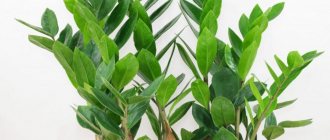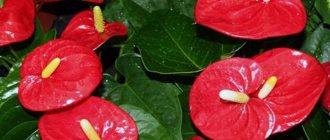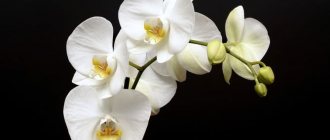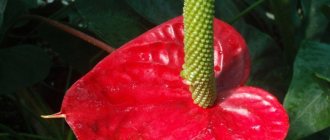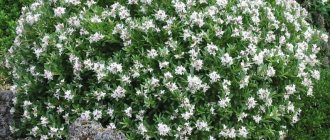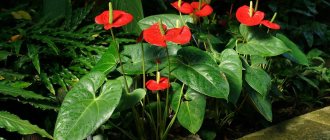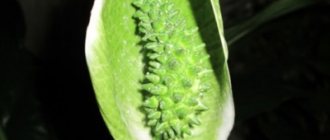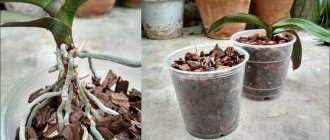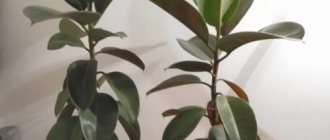Anthurium is a beautiful flower that was brought to our latitudes from the tropics. It is easily recognized by its large, heart-shaped leaves (up to 40 cm in length). The opened bud also has an interesting appearance: a flower ear in the center, surrounded by a bract of the same shape as the leaf blade. The plant is quite capricious, so this article will discuss why anthurium does not grow at home.
Causes of poor growth
The lack of development or its slow pace, as well as the impossibility of flowering, are associated with a number of reasons:
- improper lighting;
- inappropriate temperature – the flower does not like excess heat or cold;
- watering should also be at the proper level;
- the size of the pot does not correspond to the size of the anthurium root system;
- Inappropriate soil was selected for planting;
- there are not enough nutrients in the soil or fertilizing is carried out irregularly;
- the plant was transplanted in violation of the rules;
- the pot is often moved from place to place;
- the flower is in a draft;
- insufficient air humidity in the room;
- the presence of a large number of wilted buds on the plant;
- presence of pests or disease.
Next, we will describe in detail the most common causes and methods for eliminating them. By adhering to optimal growing conditions for anthurium, it will be possible to resume its growth and achieve flowering.
Rooting the top
How to propagate anthurium using the top of a flower? Often, with age, the plant stretches out, loses its decorative effect, and stops blooming. To restore anthurium and obtain new planting material, a method such as rooting the apex is used.
On an aged plant, the upper part of the stem is cleared of dried leaves and scales, and carefully wrapped in a thick layer of damp moss. An improvised bandage of plastic film is created on top of the moss pillow. This prevents moisture evaporation. New roots form fairly quickly in such a warm and humid environment. At this moment, the top of the flower is cut off below the bandage and planted in a separate pot. The new plant already has roots and is ready for independent existence.
The remaining part very quickly develops lateral shoots, which are also used for propagation, but more often form a new flamingo flower on the old root system.
These are the main methods of vegetative propagation of anthurium. Growing and propagating anthurium at home is not difficult; it does not require special knowledge, but only a little practice. Just always remember the danger of rot with this method of propagation. Places of cuts and damaged areas of roots must be treated to prevent putrefactive and fungal diseases. Finely ground coal is most often used for processing. Amateur flower growers began to use ground cinnamon for similar purposes; it also has the necessary disinfecting properties.
The main thing to remember is the need to maintain optimal conditions and provide the necessary care: high humidity, warmth, well-lit, but not sunny place.
Incorrect lighting
When trying to figure out what to do when anthurium is not growing well, the first thing you should pay attention to is lighting. The plant is distinguished by its love of sunlight, but does not tolerate prolonged exposure to direct rays on its leaves. In places where it grows naturally, the light of the sun passes through the foliage of trees, scattering sufficiently, so similar conditions must be created indoors.
A serious mistake is to install the pot in the sunniest place in the apartment. In this case, the leaf plate will get burns, turn yellow and fall off over time. A similar situation is observed when placed in the back of the room, where there is practically no light.
The ideal option for installing an anthurium pot would be a window on the west or east side of the house. This will allow you to receive a sufficient amount of lighting both in summer and winter. In the middle of the cold season, it would not be superfluous to organize artificial lighting.
Origin of the plant
The birthplace of anthurium (caring for a flower at home will be easier if you understand the origin of the plant and know the conditions for its growth in its natural environment) is considered to be Central and South America. Tropical and subtropical regions of a given state. The plant's distribution range includes Mexico, southern Paraguay and northern Argentina. There are species of anthurium that can grow in the savanna.
Currently, there are a large number of varieties of this crop with decorative foliage. Of these, many species are famous for their beautiful flowers. About a hundred hybrid varieties have been bred that can be grown as indoor, garden, and even cut flowers. The plant is capricious, and it is difficult to create the necessary conditions for it at home. Anthurium is most suitable for growing in greenhouses and terrariums.
It is important to know that the plant is poisonous, so it should be kept out of the reach of children and pets. For many years, anthurium grew in the hot and humid forests of America
In 1876, the flower was discovered by biologist Edouard Francois Andre. The plant attracted him with its unusual appearance, and he sent one specimen to the Royal Botanic Garden of England
For many years, anthurium grew in the hot and humid forests of America. In 1876, the flower was discovered by biologist Edouard Francois Andre. The plant attracted him with its unusual appearance, and he sent one specimen to the Royal Botanic Garden of England.
A little later, in 1889, Hawaiian Secretary of the Treasury Samuel Mills Damon brought anthurium from England and planted it in his garden. In the 30s, thanks to the local population, flowers spread throughout the Hawaiian Islands. In 1936, of all the known varieties, red anthurium became the most widespread. Many gardeners have mastered caring for it at home. In Russia, the flower is grown as a houseplant.
Air temperature
The development of the flower is adversely affected by the high ambient temperature in winter, when the dormant period begins, and subsequently the formation of buds occurs. The plant responds well to moderate heat, but not heat. During the cold season, the room should not be warmer than 20 degrees.
When understanding why anthurium does not grow, it is necessary to take into account that from the end of autumn the flower enters a dormant period, which lasts for 3 months. The ideal temperature at this time will be 15-17 degrees. Moderate coolness will ensure the shoots with buds are thrown out.
When flower stalks begin to form (usually mid-February), the room temperature should be at 18-20 degrees. In summer, the flower normally tolerates a range of 20-25 degrees.
Errors in watering
A stop in development can occur due to excessive watering, when the water in the pot is constantly in a swampy state. The roots will rot, which will disrupt the nutrition of the entire plant. The lack of flowering may also be due to a lack of moisture in the soil. As in other details, the flower loves the golden mean.
Moistening the soil should be done after the top layer has sufficiently dried. A large amount of water can be added at a time, but the procedure itself should be carried out infrequently.
Water requirements: soft, not cold, without calcium salts. When using tap water, it should be left in a glass container for 5 days before applying to the soil. If you use a filter, then settling is not required. The liquid should be acidified once every 7-14 days: 1-2 drops of lemon juice per liter.
Disadvantages and advantages of this method
The main advantages when growing anthurium from seeds have already been indicated in the previous subheading. To summarize, we can say that this method of reproduction comes to the rescue when other methods are not suitable for one reason or another. However, in addition to the advantages, this method also has some disadvantages. Such as:
- seeds that are ordered from other countries, in most cases, may turn out to be of poor quality, and they also quickly lose their germination capacity;
- in order for indoor flowers to grow from seeds without losing the characteristics of the mother plants, seeds from varietal specimens should be used (seeds from hybrids are not able to accurately produce an analogue of the mother plant);
- This method of producing offspring is quite energy-intensive and also requires a lot of time.
Please note that flowering of seedlings occurs when the plant reaches two years of age, while specimens propagated by cuttings are able to bloom during the first year of life
Pot
If the anthurium does not grow or bloom, an unsuitable pot may be to blame. The rhizome of the flower develops poorly, since it is an epiphyte. Such plants are always uncomfortable in deep pots. It is better to choose a container with a larger diameter than depth.
Of course, if grown for a long time, the plant may outgrow its pot. This is indicated by roots that appear under the top layer of soil or in the drainage holes below. The new container should be only 2-3 cm larger in diameter.
Lack of fertilizing
The problem of poor growth can be observed due to the lack of fertilizing, untimely application or use of an inappropriate composition. Nutrients should be added to the soil of the plant during the period of its active development - in spring and summer.
The flower is fed once a month with acidic compounds that do not contain calcium. The best choice would be liquid fertilizers specially produced for flowers. You can also use improvised means to increase acidity. For example, place pine needles or sphagnum moss under the base of the anthurium.
What advice can you give on replanting Anthurium?
Firstly, when replanting, you must remember the vulnerable roots and leaves of the plant, which are very easy to damage. To avoid an accident, you should be very careful, as Anthurium will take a long time to repair damage.
Secondly, make the transplant depth a little larger than the previous one. This will help young, small roots develop better.
Thirdly, the plant should change its pots at least once a year if it is young. It is recommended to replant old flowers every 3-4 years.
Fourthly, the flower called “male happiness” grows poorly in stagnant water or insufficient oxygen. In order to avoid these problems, it is necessary to compact the soil when replanting.
Remember also what you are planting Anthurium in. The flower prefers plastic containers because the soil and air temperatures in them are equal. The size of the pot also plays a huge role in growth. If it is too loose, it can significantly slow down the growth of the anthurium, so buy a tight flowerpot.
The soil for the plant is also selected individually. Anthurium requires a coarse fiber substrate; it should not be dense, with large lumps. Large particles will be needed in order to absorb and retain the necessary nutrients and moisture that the anthurium roots will feed on. Also, the benefit of lumps is that they will hold the plant.
The composition of the soil for anthurium also includes:
- chopped moss;
- peat;
- turf land;
- deciduous soil;
- charcoal;
- conifer bark;
- sand.
Other reasons
Sometimes it is possible to determine the reason why anthurium does not grow after measuring air humidity. The plant does not tolerate excessively dry air, so it should be sprayed several times a day with plain water. The leaves themselves can be wiped with a damp cloth - this will provide additional moisture and allow you to remove a layer of settled dust.
An incorrectly selected composition of purchased soil can also have a negative impact on plant growth. It is almost impossible to achieve flowering of anthurium if it is planted in a substrate suitable for the bromeliad families of flowering plants or cacti. A peat mixture will not work either. The soil should allow oxygen to pass through and be slightly acidified. A good option would be a mixture for orchids.
The presence of a large number of wilted buds on the bush takes away the plant’s strength, which is spent on forming seeds. The faded bud should be cut off with a sharp knife or scissors.
Advantages and disadvantages of the method
Vegetative propagation methods have one important advantage compared to seed germination: an adult plant capable of flowering can be obtained in just a few months. In addition, caring for tiny seedlings requires great attention, otherwise the fragile sprouts may die
In the case of rooting cuttings, everything is much simpler.
When propagating and carrying out other manipulations, you should definitely remember that anthurium, like most representatives of its species, is a poisonous plant. When anthurium juice comes into contact with the skin, symptoms characteristic of allergic reactions occur: itching, irritation, redness. If accidentally ingested, the juice can cause serious poisoning.
Attention! When carrying out any operations with a plant that can cause damage to it, it is imperative to use rubber gloves. After completing work, hands should be washed thoroughly.
